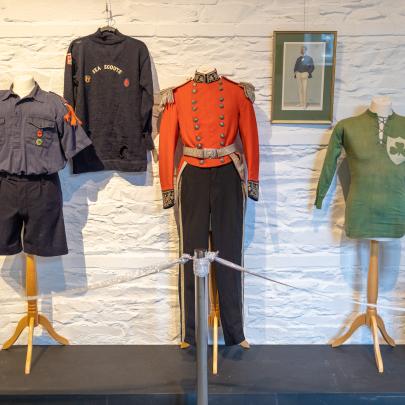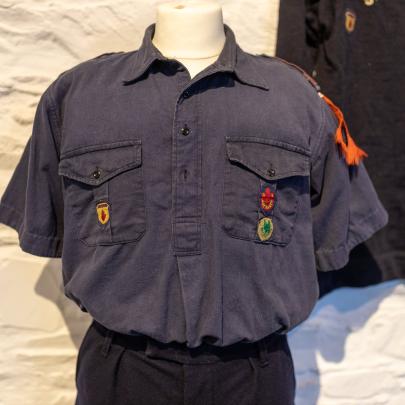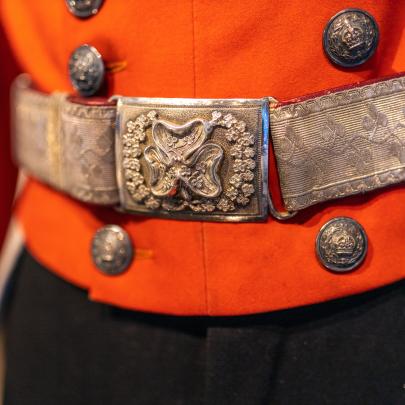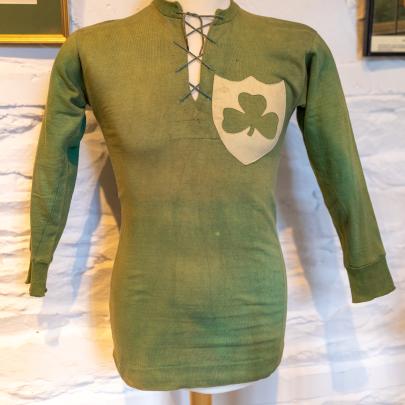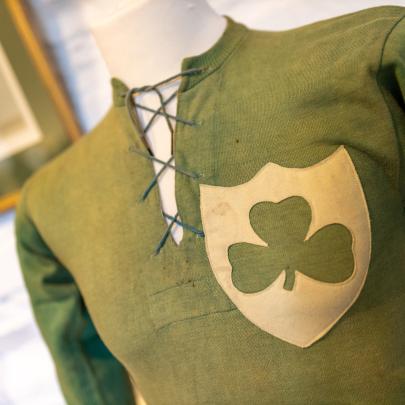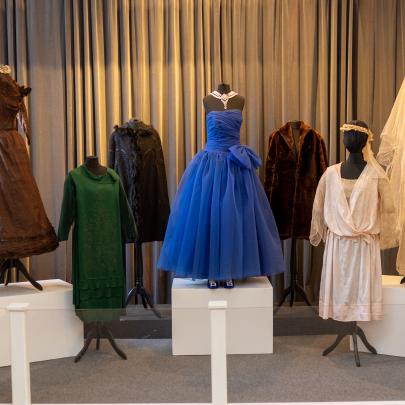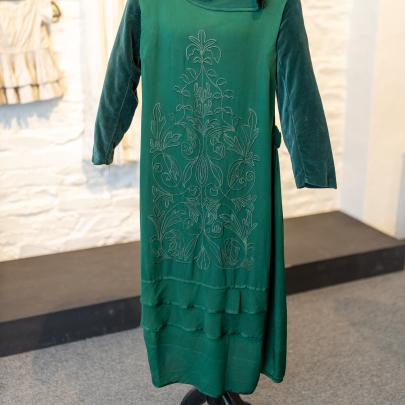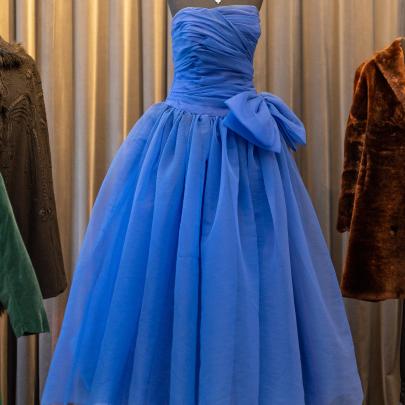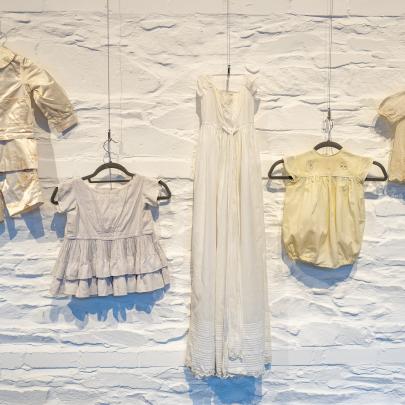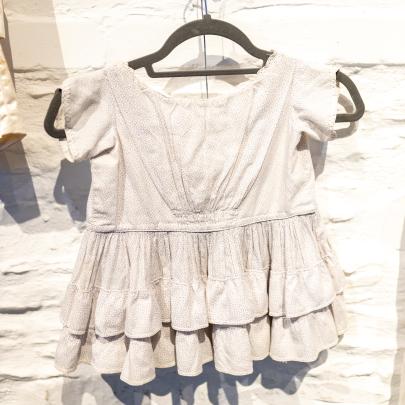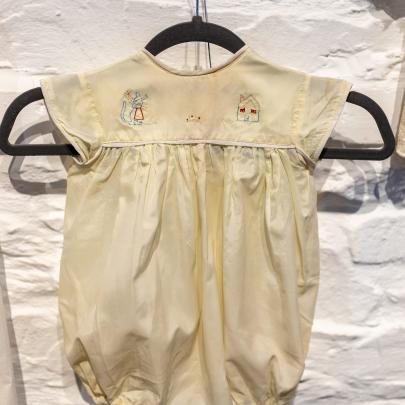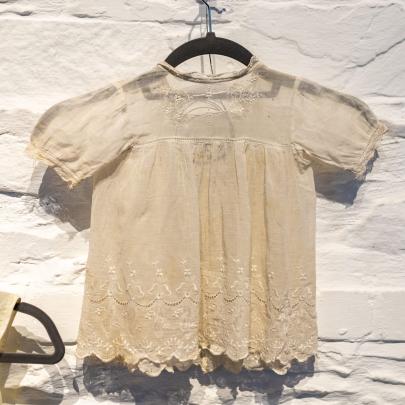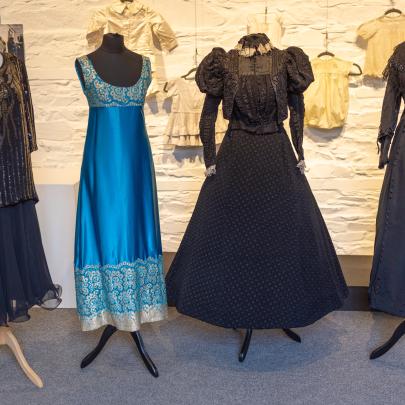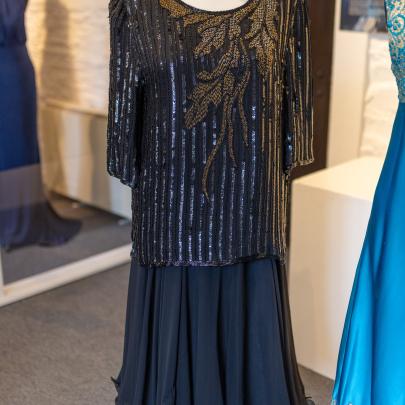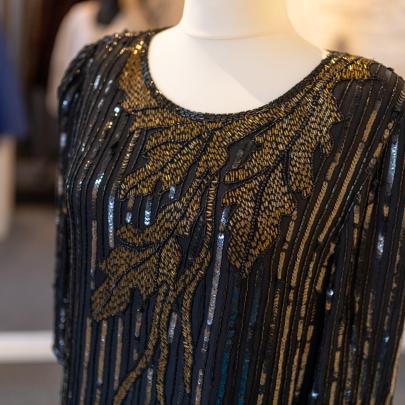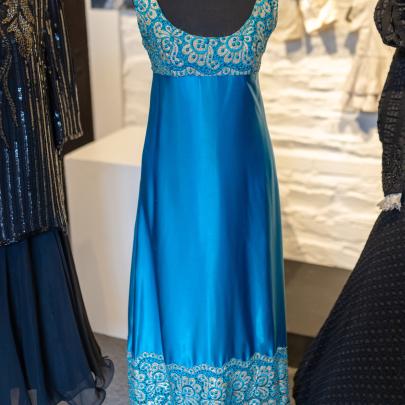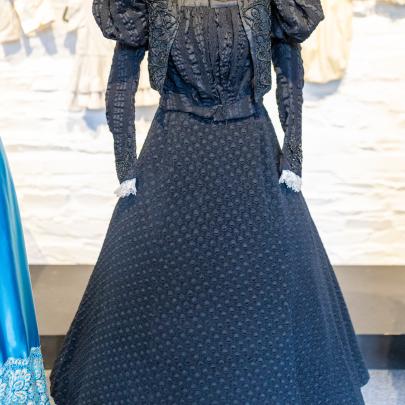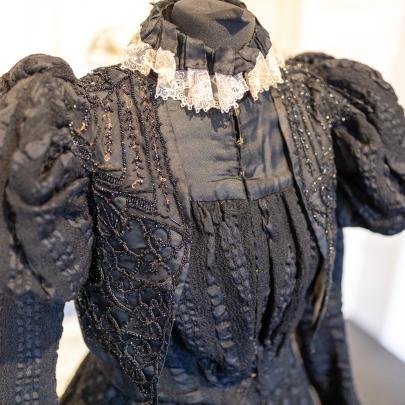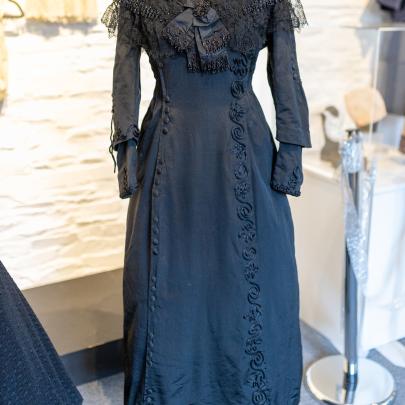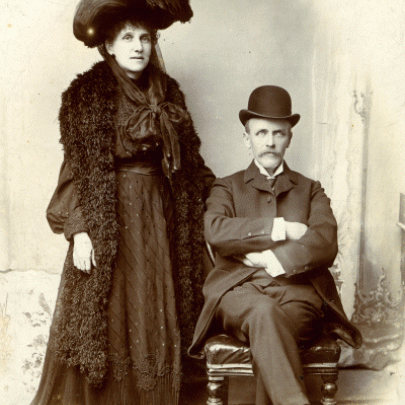North Down Museum has a small but fascinating collection of clothing that we have acquired over the years. Ranging from civic ceremonial robes to military uniforms to wedding dresses. This exhibition, which opened in the museum at the end of September, showcases this collection.
As the museum had to close on 16 October due to the latest COVID-19 restrictions, we have put the exhibition online to give people who may have missed it, the opportunity to view it. Below is a walkthrough video of the exhibition along with some images and more detailed information on selected items. We hope you enjoy it.
Talk a walk through the 'What We Wore' clothing exhibition..
Men's Wear
Below is a selection of the some of the men's wear from the Collection. Please click on the images to enlarge.
- Sea Scouts Uniform:
This Sea Scouts uniform was owned by William Harmer (Wilfie) from Donaghadee who joined the Dee Scouts Pack Club in 1944. Back then they held their meetings in a Nissan hut in Cannyreagh Road then moved to the Parish Hall, corner of New Road and Warren Road. Wilfie's brother George was Scout Master and Wilfie became Assistant Scout Master. They camped first in Millisle with a track cart pulled behind for their tents, then later the pack camped in Scotland, outside Edinburgh and in Weaverham North Wales and also Dunlear, Co. Louth.
- Lord Lieutenant of Ireland Uniform
The role of Lord Lieutenant of Ireland was established in 1171 with the position being filled until the partition of Ireland in 1922. More commonly known as 'Viceroy', the Lord Lieutenant was the Monarch's official representative in Ireland. County Lieutenancies, in the British mould, were introduced in 1831. The Government of Ireland Act 1920 abolished the Irish Lieutenancies except in the north. It is believed that this uniform is from the early 20th Century and may have been worn either by the 6th or 7th Marquess of Londonderry, who served as Lord Lieutenant of County Down between 1902 - 1915 and 1915 to 1949 consecutively.
- Irish Football Association of Ireland Uniform
This football memorabilia comes from local man Ernie Watson. Ernie began his football career playing for Bangor Young Men and then went on to play for Bangor and Cliftonville before becoming a Northern Irish Amateur international player. Unfortunately, Ernie Watson lost his life in the Second World War. The family contacted the museum to see if they would like to add some of his pieces to the collection. The collection includes Ernie's jersey and cap as well as a medal which states Lyttle Trophy won by Bangor 2nd F. C. E Watson 1929 - 1930 and photos of him in his kit.
Women's Clothing
Women's clothing from the Collection. Please click on the images below to enlarge.
- Brown Victorian Dress
Little is known about this stunning late Victorian dress. The McKee family story tells of their ancestor who travelled from Ireland to America in the 1800s on several occasions to assist her family in acquiring land in the West, so this dress maybe have crossed American in a Conestoga wagon!
- Green 1930s Dress
North Down Museum's preference is to collect dresses of local people but occasionally will take in items from elsewhere if they can be used to fill 'gaps' in the collection or can be used as a 'prop' to help tell stories. This dress is such an example and was transferred to the collection from Milford House Museum in Armagh.
- Blue 1950s Dress
Little is know about this beautiful dress which was donated by Barbara Carnew. The style would suggest that it was worn for more formal occasions. It is believed to date from the 1950s.
- 1920s Wedding Dresses
The pale pink silk wedding dress (on the left) was worn by Hannah Semple in 1924, at Eglington Presbyterian Church in Londonderry. The gold dress (on the right) was worn by Gladys Mary Pollock when she wed Robert Hogg Forbes on 6th June 1924.
Children's Clothing
The museum also holds a small collection of children's items. Click on the images to enlarge.
- Boy's Wedding Outfit
Little is known about this outfit but it was donated alongside the blue 1950s dress and a small collection of men's formal attire. It does appear to be an outfit for a special occasion such as a wedding. Donated by Barbara Carnew.
- Child's Dress
White and purple tiered children's dress donated from the Milford House Collection.
- Christening Gown
Christening gown worn by Anne Fadzean over 100 years ago and handed down the family to her daughter Anne Musgrave. Donated by Brian Musgrave.
- Yellow Romper Suit
Yelllow child's romper suits with a sateen finish; white horses with red reigns embroidered on the bodice; neckline finished with white binding. Belonged to the donor's mother.
- Period Child's Dress
Period long-sleeved fine cotton child's dress with drawn threadwork in the shape of petals which gathers the skirt of the dress. Made by the donor's mother-in-law Mrs. Catherine Wilson. Both donated by Richard Livingston.
Recent Donations
The museum recently launched an appeal for local people to donate items to the Clothing Collection. Many people responded to the appeal and gave the museum some wonderful pieces of vintage clothing. Here is a selection of what was received:
- Black 1980s Dress
This gorgeous dress screams 1980s with its shoulder pads, beading and flounced skirt. The label is Frank Usher which shows its quality. Worn by Jean Scott to an important conference her husband was invited to, she also donated the shoes and handbag that went along with the outfit.
- Blue 1960s Dress
This stunning dress, was made in 1969 from Indian Satin was worn by Barbara Mayne. It was made in Tanzania by a Dutch Seamstress.
- Black Victorian Dress
We have little history regarding this magnificent black bodice and skirt which belonged to Martha Hillis, but there are a few clues to help to date it. First of all it is machine made and has the label ‘Samuel McManus, Dungannon and secondly, the style of dress with its two parts, small waist and voluminous skirt indicates that it dates to the 1850s to 1860s. Donated by Maxine Nelson.
- Late Victorian Wedding Dress
This wedding dress belonged to Emily Leckey. In the 19th Century brown and black were common colours for wedding dresses. The dress is satin grograin with a silk lace insert at the neck. The Leckeys were a Holywood family and Emily's mother owned the fishing rights for Belfast Lough and built the row of red brick houses on the Esplanade in Kinnegar in the mid 19th century. After her marriage in 1887, Emily moved to Antrim Rd Belfast and helped her husband set up a successful painting and decorating business. They had 8 children. Emily died in 1945. Pictured below is Emily with her husband Matthew Gibson. The dress was donated by Emily's great-granddaughter Heather Gibson.
.
You might also like
What We Can't See Now Will Last Forever
-
Ensoulment
-
Exhibition Preview: February
-
Drawn Together
-

